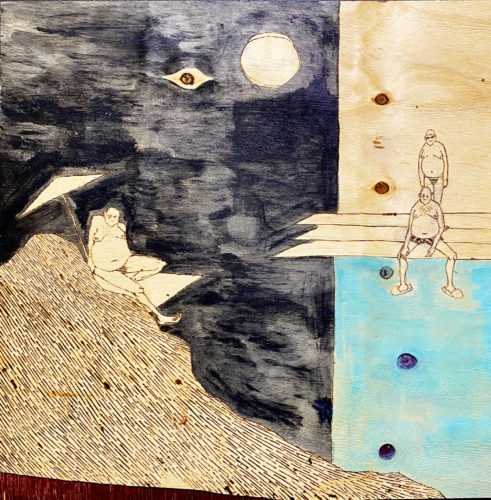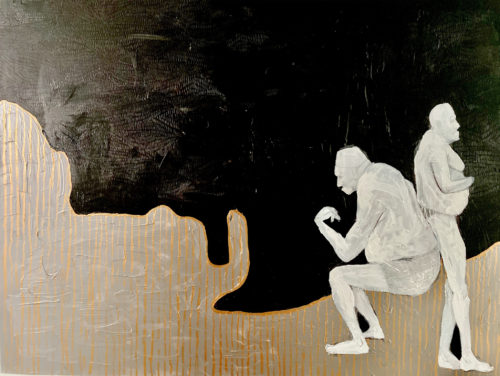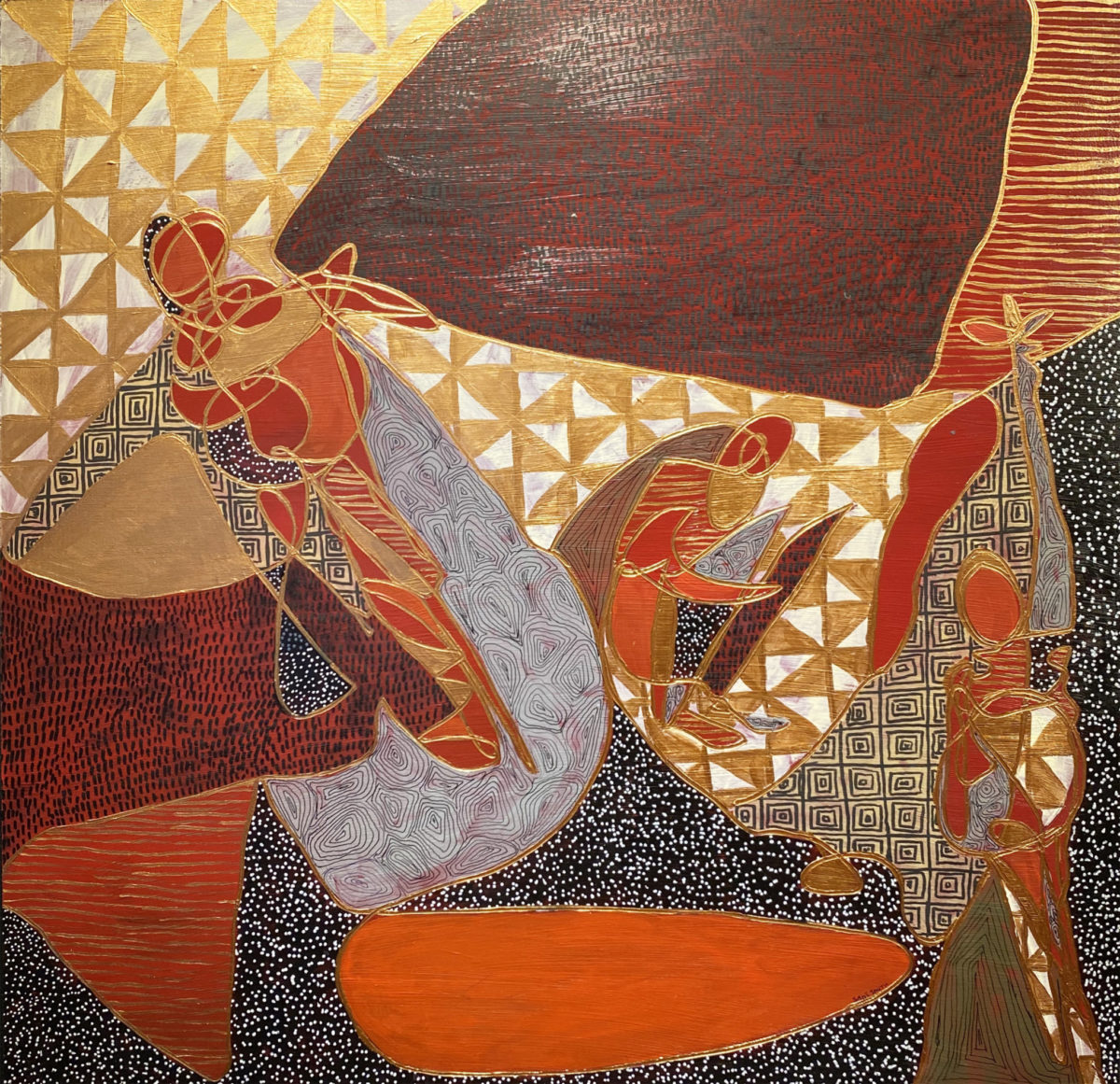Amid a pandemic and civil uprisings, many artists are trying to figure out how to make social and personal impacts through their work. For Sage Smith, her work both speaks to the importance of her identity and transcends the idea of being mono-cultural. She grew up on the South Side and is currently pursuing a Master of Arts in Arts Education and Bachelor’s in Painting at the Maryland Institute College of Art. She just completed her first solo show, The Barriers That Create Us, at Connect Gallery (1520 E. Harper Ct.) in Hyde Park, which ran from August 2 to August 9 and featured an in-person, socially distanced artist talk at its opening. Smith sat down with South Side Weekly to talk about her therapeutic relationship with patterns, line work, and motion, and how she strives to create work outside of what society believes Black creatives should be making. The interview has been edited for clarity and length.
How do you mentally set up your environment to create?
It’s definitely different working at home after having gone to Baltimore, [where] I have a studio space. All of our dorms have giant studios that you can go work in, and not having access to that I started working in just the corner of my house, but I know that personally what I need is a level of comfort. It was really about finding that space here because I had already established that in Baltimore, sort of like purchasing a bean bag chair so that I could sit and focus on making a pattern for hours. It just has to be extremely peaceful; I don’t really like a lot of music, I’ll usually listen to a book. It’s not high energy, it’s very meditative.
How do you start your creative process?
Usually, I start off with a line drawing—I don’t really plan too much or sketch things out a whole lot. I’ll section off the piece and then I build up a color language from that, and then from that, I’ll build up a pattern language. They all usually start out with a line drawing of sorts that gets layered upon.
What has your first solo show at Connect Gallery meant to you, especially now?
I sort of developed an aversion to making political work in college. I think that even more so during this time there was that expectation, and I saw this tweet that said “Artists during this time, just create.” And it didn’t say anything about what we should be creating about, it just said create, and I think I really took that to heart as validation that I don’t have to create work about the time, and it’s still work about the time.
I had done group shows before, but this is the first time that I could really say anything [about my work]. It was very important for me to talk about something that I felt was very important to me, which was this environment, this space, that’s really what the show became about, but it was so many different ideas bouncing around in the show which made it amazing. It was the first time I had ever gotten to say anything that I wanted, I compare it to like, your first creative writing assignment where you just write anything. It doesn’t have to be a story, it doesn’t have to be a poem, write anything. So that’s kind of how I felt.

Is this something that you felt like you haven’t been able to do, or is it just a different method of doing it than your work has been able to do?
Yes, I just felt unfiltered, unedited, unapologetic. It was just raw, it’s what I felt like creating without having to justify it or tweak it into someone else’s idea or make it for a homework assignment for school. It felt like, wow, I just made these [paintings] just to make them and this a story that I was talking about, and it all kind of came together.
How do you think language works within the motion, line, and pattern work that you do?
The way I use the word “language” is usually to convey stylistic choice, like I’m using this language of style to communicate this from one line to an extremely flat piece that sort of conveys depth but was not made with one line. I think a lot of what I’m talking about when I was using the word “language” was using the same sort of letter but just in a different word. My pattern work and my avatar character, who I drew since high school, helped me to convey these emotions of existence in different spaces throughout this show. I’m not sure what I wanted people to get from it. I got a lot of different responses on race, on homosexuality, on a lot of these things, which I didn’t necessarily intend because I think that’s of course part of my prerogative, you know, not necessarily making outright comments on those.
As an artist, putting work out there in a very direct way can be limiting. Art can be about complexity, it can tell the intended story but then it can tell so many different other stories as well.
Yeah, I’m not one for imposing my meaning on others. I really enjoy listening and learning what different lenses and different perspectives and different people take from different pieces. That was probably the best part of the entire show.
Has that worked well with the group shows, or is there another way that you show your work that allows you to get that feedback or interaction?
I think that’s why I dive so heavily into abstraction. I don’t use a lot of symbolism in my work. … You take what you want from it. I don’t necessarily enjoy having to explain it. I know it’s weird because I’m doing an interview [laughs] but it’s very hard for me because I told you where I’m at, where I’m creating is just a peaceful, cozy moment and it’s really hard to let other people into that moment because it just seems so private. Then once you put the work out there it’s for everyone else. I’m still coming to terms with that aspect.
Do you feel like going into depth about that process is exposing that private space? Where do you feel like that line is between what you put out and what you try to keep for yourself?
I definitely talk about my process, but it’s always something that I do alone. Most recently I started filming time lapses just to see, but I usually don’t like people in my space while I’m working. I’m like, get out of the way! [laughs] You know, it’s just a very private way to create. I know other artists who need someone around to create because they need to bounce ideas off of people. But I think that’s something that will always remain private, whereas the work, I’m gonna put it out there and it won’t be mine anymore. It’ll be open to all these other things, but I think my creation process will always be a lot more personal.

How important is it to know your background of Afro-Latinx queerness in looking at your work?
It was a big part of The Barriers That Create Us, just talking about how different environments and experiences have shaped you, and I think I wanted to acknowledge how a lot of my experiences have shaped me. Whether it was being at a predominantly white institution, whether it be my cultural influences, racial influences, that aren’t necessarily in the work outright but definitely affect how I move through the world and how I will always process things. I think it’s always important; in no way is me not talking about race in my work [meaning] that I do not want to be acknowledged by race. It’s not as if I’m trying to edit it out by not talking about it. I just think as an Afro-Latinx queer person I don’t necessarily always have to talk about those things in order to be acknowledged as an Afro-Latinx queer artist.
Where do you see your work going in the next couple of years?
I don’t know! [laughs] I’m just trying to focus on getting my degree and wherever that goes, I will follow. I’m definitely excited for bigger, probably have more of my avatar show in my work, I really enjoy the way that people talked about him because of course my experience with him is deeply personal but how he also becomes a way for people to project themselves into the environment. You know, so I thought out of my social experiment of an art show [laughs] that was very interesting that I definitely will keep up with.
[Get the Weekly in your mailbox. Subscribe to the print edition today.]
Have you thought about utilizing any different mediums or methods in the future?
Definitely interested in a lot of the above. I have a lot of classes that I’m taking in architecture, printmaking, weaving, and fibers, so I’m definitely planning on in the next couple years experimenting a lot more with surface, medium, language. I’m definitely still experimenting and not limiting myself to only one language.
Roderick Sawyer is an artist, writer, and Chicago native. Sawyer occasionally contributes arts stories to the Weekly.

